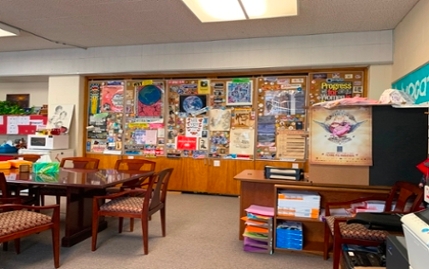Opening Doors, Digitally

Course: ARTS 315-01, Advanced Web Design
Instructor: Jonathan Gibson, Professor, Art Department
Partner: Intercommunity Justice & Peace Center
Title: Opening Doors, Digitally
Inside the Intercommunity Justice & Peace Center’s (IJPC) office, there are several expanding closet doors coated with buttons, stickers, and posters representing the 35 years of movement building, advocacy for justice on the behalf of individuals, and the group’s commitment to systemic change. While we may be distanced from each other right now, Professor Jonathan Gibson’s Advanced Web Design course, which carries a service-learning attribute, is working hard to expose to IJPC’s web visitors three decades of advocacy for peace and non-violence through digital means.
Allison Reynolds-Berry, executive director of IJPC, is grateful for Gibson’s class collaboration around this important project.
“This project helps our mission because it tells the story of IJPC in a way that hasn't been heard before,” Reynolds-Berry said. “It highlights the stories, like IJPC's involvement in the sanctuary movement that took place in the 80's and still has relevant connections to our work now. Our hope is that these stories will encourage people to get involved in our work.”
The class is working to digitize 35 photographs, newspaper articles, and longer narratives that appear on the doors. Once complete, visitors to IJPC’s website will be able to click on any one of the uploaded images and watch a video of someone telling the story of its significance.
Gibson believes that, due to our current situation, we need to find ways to connect with our community, even if it is only through digital means.
“Given the current physical separation we are experiencing, it is more necessary than ever to engage with others,” Gibson said. “Finding creative ways to serve, reach out, and partner with others in difficult times will always be the hallmark of any successful and responsive organization.”
While it has been challenging due to the switch to remote learning, Gibson’s class has been jumping over the obstacles and problems that have risen.
“It involves a little more work to align academic timelines with client/community partner needs and deadlines. There is an additional commitment to timely communication with the client,” Gibson said. “Luckily this class is web design, so it's relatively easy to meet virtually and work on projects remotely.”
According to Reynolds-Berry, the original goal of having a digital product has been beneficial.
“Since the work on this piece is centered around a digital product, we were able to continue to move forward quite easily with the project,” Reynolds-Berry said. “Our timeline was interrupted and creating video interviews has been a challenge, but we've been able to talk to religious sisters via Zoom in their homes and record them that way — rather than bringing a camera to them as we had originally hoped.”
While the work being done in his class is surely different than he must have imagined it to be when he was putting it together, Gibson still believes service-learning is a necessary part of the Jesuit education.
“I have learned from past experience that adding the service learning aspect to any course improves student engagement and motivation, creates a real-world learning environment, and allows our program to increase its exposure and reputation in the community,” Gibson said, “Most importantly it allows us to engage in the service mission of Xavier. It's an incredibly rewarding experience for everyone involved.”
Reynolds-Berry agrees with the importance of this aspect, and added her appreciation for the work her organization may not have been able to do without their help.
“We love connecting students with real applications for their fields of study,” Reynolds-Berry said. “It's also incredibly helpful for us as an organization to have additional support from students who have a skill set, interest, and time beyond what our staff has capacity to do.”